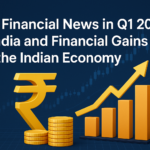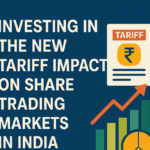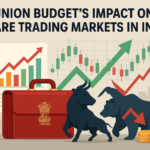Table of Contents
- Introduction
- What Are Tariffs?
- New Tariff Policy Announced in 2025
- Historical Impact of Tariff Changes on Stock Markets
- Sector-Wise Analysis of Tariff Impact
- a. Automobiles
- b. FMCG and Consumer Durables
- c. Metals and Mining
- d. IT and Software Exports
- e. Agriculture and Fertilizers
- Impact on FIIs and Institutional Investors
- Volatility and Retail Investor Sentiment
- Strategies for Investors Amid Tariff Changes
- Expert Views and Analyst Opinions
- Long-Term vs. Short-Term Investment Outlook
- Risk Management in a Tariff-Affected Market
- How to Track Tariff Announcements and Market Movements
- Conclusion
- FAQs
1. Introduction
The Indian share market is no stranger to economic shocks and policy changes. One of the most critical influences on the market is tariff regulation. The Union Budget 2025 and subsequent tariff announcements by the Government of India have introduced significant changes in import and export duties across various sectors. This blog post delves deep into the new tariffs and how they are impacting the Indian stock market in 2025.
Whether you’re a long-term investor, short-term trader, or just starting your journey in the world of investing, understanding the effect of these new tariffs on various sectors and stocks is crucial for informed decision-making.
2. What Are Tariffs?
In simple terms, tariffs are taxes imposed by a government on goods and services imported into (or exported from) a country. They serve multiple purposes:
- Protect local industries
- Generate revenue
- Control trade deficits
- Influence foreign trade relations
Tariffs often have a direct impact on company profitability, product pricing, inflation, and consumer demand, making them a major economic lever with far-reaching consequences in the stock market.
3. New Tariff Policy Announced in 2025
In the Union Budget 2025, the Indian government introduced a new series of tariff reforms. Some key highlights include:
- Increased import duties on electronic components, finished electric vehicles, and foreign solar panels.
- Reduced tariffs on certain raw materials used in manufacturing, including lithium-ion battery components and semiconductors.
- Introduction of anti-dumping duties on cheap steel imports from select countries.
- Agricultural export incentives with a focus on self-reliance and boosting rural income.
- New tariffs on Chinese imports, especially in electronics and machinery, as part of an aggressive “Make in India 2.0” push.
These measures aim to strike a balance between protecting domestic industries and encouraging local manufacturing, but they have had divergent effects across sectors.
4. Historical Impact of Tariff Changes on Stock Markets
To understand the significance of tariffs, let’s look at past instances:
- In 2018, the U.S.-China trade war caused global market volatility, including in Indian equities.
- The 2019 increase in gold import duties led to a rally in domestic jewelry stocks like Titan and Kalyan Jewellers.
- The 2020 reduction in import tariffs on medical devices post-COVID-19 led to growth in the healthcare and pharma sector.
Thus, tariff-related announcements frequently lead to sectoral shifts, rotation of capital, and short-term volatility, all of which create opportunities and risks for investors.
5. Sector-Wise Analysis of Tariff Impact
a. Automobiles
Tariff Impact:
Import duties on electric vehicle (EV) components have increased, favoring local manufacturers.
Winners:
- Tata Motors (EV segment growth)
- Mahindra & Mahindra – Robust EV pipeline
- Olectra Greentech – Electric bus maker benefiting from domestic sourcing
Losers:
- Hyundai and Kia India – Depend on foreign imports
- Luxury car makers like Mercedes and BMW
b. FMCG and Consumer Durables
Tariff Impact:
Increase in import duties on air conditioners, LED panels, and certain processed foods.
Winners:
- Voltas, Blue Star – More demand for locally made appliances
- Dabur, Marico – Benefit from rural incentives and reduced competition
Losers:
- Companies relying on imported raw materials
- Electronics firms importing core components
c. Metals and Mining
Tariff Impact:
Anti-dumping duties on Chinese steel and aluminum have caused price surges.
Winners:
- JSW Steel, Tata Steel – Domestic suppliers gain pricing power
- Hindalco – Diversified export-import base
Losers:
- Infrastructure companies dealing with increased input costs
d. IT and Software Exports
Tariff Impact:
Export-oriented sectors largely unaffected but potential retaliatory tariffs in international markets may impact sentiment.
Winners:
- TCS, Infosys, HCL Tech – Stable due to global contracts
- Strong USD/INR rates act as a buffer
Losers:
- Smaller IT firms focused on Asia-Pacific markets with exposure to trade disruptions
e. Agriculture and Fertilizers
Tariff Impact:
Tariff reduction on potash and phosphate-based fertilizers boosts agri-sector.
Winners:
- Coromandel International
- UPL, GNFC
Losers:
- Minimal, as government subsidies continue to cushion price changes
6. Impact on FIIs and Institutional Investors
Foreign Institutional Investors (FIIs) are highly sensitive to policy and regulatory changes. Tariffs can:
- Increase inflation, lowering returns
- Reduce sector attractiveness
- Trigger outflows or rebalancing of portfolios
As of April 2025, data from NSE and NSDL show a mixed trend:
- FIIs pulled out ₹3,400 crore from automotive and electronics sectors
- Added ₹5,000 crore to metals, pharma, and agri stocks
Conclusion: Tariffs trigger a sector-specific rotation in FII strategies.
7. Volatility and Retail Investor Sentiment
Retail investors often react swiftly to headline news. In the week following the tariff announcements:
- The Nifty 50 dipped by 1.4%, recovering later
- Volatility Index (India VIX) spiked by 9%
Retail traders turned toward defensive sectors like FMCG and pharma. However, low-cost brokerage apps like Zerodha and Upstox saw increased activity, indicating speculative participation in stocks like Adani Green, Tata Power, and JSW Steel.
8. Strategies for Investors Amid Tariff Changes
- Stay Sector-Focused: Rotate into sectors benefiting from tariff hikes or protectionism.
- Buy on Dips: Corrections post-policy announcements are often overreactions.
- Track Import/Export Exposure: Analyze the balance sheet impact of changing input costs.
- Diversify Portfolio: Reduce concentration risk by investing in multiple sectors.
- Use SIPs: Systematic Investment Plans reduce the risk of timing the market.
9. Expert Views and Analyst Opinions
Motilal Oswal:
“Tariff protection on electric vehicle components will boost domestic players like Tata Motors and M&M. We maintain a positive stance on these stocks.”
ICICI Direct:
“Metal stocks are poised for a medium-term rally due to anti-dumping duties. Investors can look at JSW Steel with a 12-month target of ₹920.”
Nirmal Bang:
“Investors should remain cautious of sectors heavily reliant on imports like electronics and luxury goods.”
10. Long-Term vs. Short-Term Investment Outlook
| Investment Horizon | Recommended Sectors | Strategy |
|---|---|---|
| Short-Term (0–6 months) | Metals, Agri, FMCG | Swing trading and sector rotation |
| Medium-Term (6–12 months) | Auto, EV, Pharma | Buy on dips, accumulate fundamentally strong stocks |
| Long-Term (1–3 years) | Infrastructure, IT, Green Energy | SIPs, staggered investments |
11. Risk Management in a Tariff-Affected Market
- Set stop losses on high-volatility stocks
- Avoid leveraged positions in uncertain sectors
- Use options or futures to hedge risks (advanced)
- Keep a cash buffer to deploy during dips
- Monitor inflation and RBI policy response
12. How to Track Tariff Announcements and Market Movements
Key Resources:
- NSE India Tariff News
- Moneycontrol Market Live
- Ministry of Commerce Press Releases
- SEBI Circulars and Guidelines
13. Conclusion
The new tariff structure of 2025 has undeniably reshaped India’s investing landscape. While some sectors stand to gain significantly, others may face short-term pressure. Investors who understand these shifts and adapt their strategies accordingly can find profitable opportunities amidst the volatility.
By diversifying, staying informed, and focusing on fundamentally sound companies, you can navigate the challenges of a tariff-impacted market and grow your portfolio even during uncertain times.
14. FAQs
Q1. Are tariffs good or bad for investors?
Tariffs can be both. They help local industries but may increase costs for some companies. Investors must analyze on a sector-by-sector basis.
Q2. Should I exit stocks in sectors hit by tariffs?
Not always. Evaluate whether the company has pricing power or can shift to local sourcing.
Q3. How do tariffs affect inflation?
Tariffs on imports may increase consumer prices, impacting inflation. This can affect RBI’s interest rate policy and thus stock valuations.
Q4. Are there ETFs that benefit from domestic-focused industries?
Yes, ETFs like Nifty India Consumption or PSU-focused ETFs benefit from local demand and policy-driven growth.






